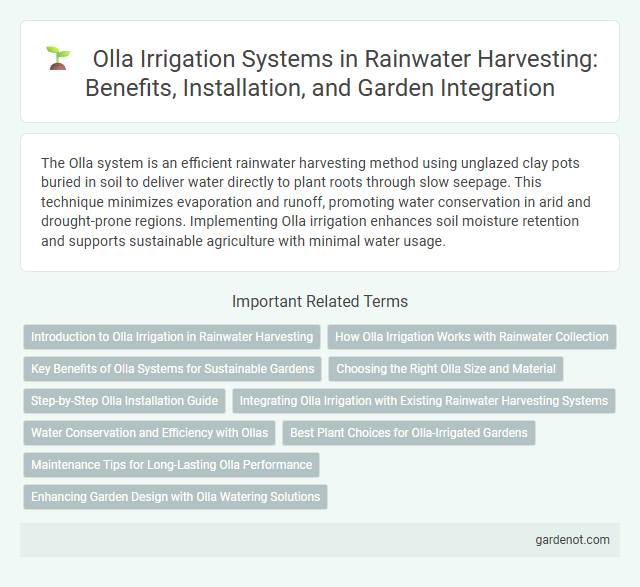The Olla system is an efficient rainwater harvesting method using unglazed clay pots buried in soil to deliver water directly to plant roots through slow seepage. This technique minimizes evaporation and runoff, promoting water conservation in arid and drought-prone regions. Implementing Olla irrigation enhances soil moisture retention and supports sustainable agriculture with minimal water usage.
Introduction to Olla Irrigation in Rainwater Harvesting
Olla irrigation is an ancient rainwater harvesting technique that uses unglazed clay pots buried near plant roots to deliver water slowly and efficiently. This system minimizes evaporation and runoff, optimizing water use in arid and semi-arid regions. By maintaining consistent soil moisture, Olla irrigation enhances plant growth and conserves valuable rainwater resources.
How Olla Irrigation Works with Rainwater Collection
The Olla irrigation system uses porous clay pots buried in the soil to slowly release stored rainwater directly to plant roots, reducing evaporation and water runoff. Rainwater is collected from surfaces such as rooftops or catchment areas and channeled into these pots, ensuring efficient water conservation and deep soil moisture. This traditional method enhances irrigation efficiency by maintaining consistent soil hydration through controlled, localized water delivery.
Key Benefits of Olla Systems for Sustainable Gardens
Olla systems significantly enhance water efficiency by delivering moisture directly to plant roots, reducing evaporation and runoff. Their porous clay construction allows slow water release, promoting deep root growth and healthier plants while conserving water in drought-prone areas. This sustainable irrigation method lowers water consumption by up to 70%, making it ideal for eco-friendly gardening and xeriscaping applications.
Choosing the Right Olla Size and Material
Selecting the appropriate olla size depends on the garden's water needs and soil type, with larger ollas being ideal for deep-rooted plants and clay soil retaining moisture longer. Terra cotta remains the most effective material due to its porous nature, promoting slow water release and reducing evaporation. Proper sizing and durable, breathable materials optimize rainwater harvesting efficiency, ensuring sustainable irrigation and healthier plant growth.
Step-by-Step Olla Installation Guide
Begin Olla installation by digging a hole slightly larger than the olla's diameter to ensure stable placement and proper soil contact. Place the olla so that the neck remains above ground for easy watering access, then fill the space around it with soil to secure it firmly. Finally, cover the neck to minimize evaporation and insert plants nearby to allow gradual water absorption through the porous clay walls.
Integrating Olla Irrigation with Existing Rainwater Harvesting Systems
Integrating olla irrigation with existing rainwater harvesting systems enhances water conservation by slowly releasing stored moisture directly to plant roots, reducing evaporation and runoff. The porous clay ollas complement rainwater catchment structures such as rooftop and surface collectors by optimizing water use efficiency in arid and semi-arid regions. This synergy maximizes sustainable irrigation practices, improving soil hydration while minimizing water waste.
Water Conservation and Efficiency with Ollas
Olla systems enhance water conservation by using porous clay pots buried in soil to deliver water directly to plant roots, minimizing evaporation and runoff. This traditional irrigation method increases water efficiency by maintaining consistent soil moisture, reducing the frequency of watering and overall water usage. Studies show ollas can reduce water consumption by up to 50% compared to conventional watering techniques.
Best Plant Choices for Olla-Irrigated Gardens
Olla-irrigated gardens thrive with drought-tolerant plants such as succulents, native perennials, and Mediterranean herbs like rosemary, thyme, and lavender, which efficiently utilize the slow-release water from the clay pots. Deep-rooted vegetables like tomatoes, peppers, and eggplants also benefit from the consistent moisture provided by the Olla system, promoting healthier growth and higher yields. Selecting plants adapted to semi-arid conditions maximizes water conservation and ensures optimal performance of rainwater harvesting through olla irrigation.
Maintenance Tips for Long-Lasting Olla Performance
Regularly check and clean the olla to prevent clogging caused by sediment buildup, ensuring efficient water absorption. Inspect the clay material for cracks or damage and repair any found to maintain the system's integrity. Keep the surrounding soil free of weeds and debris to enhance water infiltration and prolong the olla's lifespan.
Enhancing Garden Design with Olla Watering Solutions
Olla watering systems improve garden design by delivering precise, slow-release irrigation directly to plant roots, promoting healthier growth and conserving water. Incorporating ollas into landscaping reduces surface evaporation and runoff, making gardens more sustainable and efficient. Their unintrusive, buried design allows for flexible, aesthetically pleasing arrangements while maintaining optimal soil moisture.
Olla system Infographic

 gardenot.com
gardenot.com